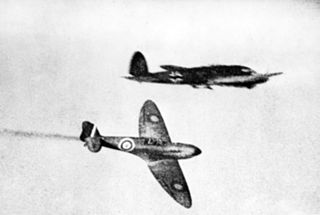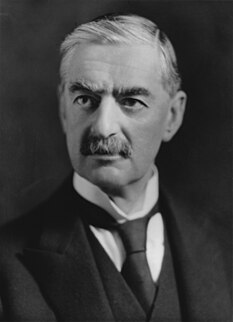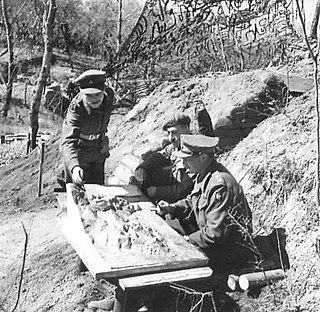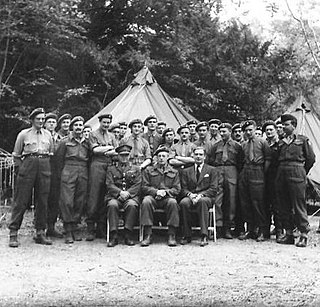 W
WThe British airborne forces, during the Second World War, consisted of the Parachute Regiment, the Glider Pilot Regiment, the airlanding battalions, and from 1944 the Special Air Service Troops. Their formation followed the success of the German airborne operations, during the Battle of France. The British Prime Minister, Winston Churchill, directed the War Office to investigate the possibility of creating a corps of 5,000 parachute troops.
 W
WImpressed by the German airborne force during the 1940 Battle of France, the British Prime Minister, Winston Churchill, ordered the creation of a paratrooper force of 5,000 men. The success of Operation Colossus, a small scale commando raid, prompted further expansion of this force, and resulted in an additional requirement for a glider force of 10,000 men to be created. The recruitment for the size of this force took through to 1943, by which time two divisions had been formed. The airborne division was to comprise three brigades: two parachute brigades, each with three battalions from the Parachute Regiment, and an airlanding brigade with three infantry battalions. The first parachute battalions were formed from volunteers from across the British military. As the airborne force grew, infantry battalions were selected to be converted into parachute battalions. The men were invited to volunteer for parachute service, or assigned to a new unit. The new battalions were then brought up to strength from volunteers from other units. The airlanding battalions came from existing infantry units that had been converted into this new role, and the soldiers did not have the ability to opt-out. The latter were flown into battle via gliders, while the former parachuted in.
 W
WThis page is a list of British Armies in World War II. It is intended to provide a central point to access information about British formations of that size.First Army (1942–43) Second Army (1943–1945) Fourth Army Eighth Army (1941–1945) Ninth Army (1941–1945) Tenth Army (1942–1943) Twelfth Army (1945) Fourteenth Army (1943–1945)
 W
WDuring the Battle of Britain, the defence of the UK's airspace was divided up within RAF Fighter Command into four Groups, each comprising several airfields and squadrons.
 W
WThis is a list of the officially accredited Battle of Britain units with their aircraft types, code letters, call signs and casualties.
 W
WThis is a list of British Brigades in the Second World War. It is intended as a central place to access resources about formations of brigade size that served in the British Army during the Second World War.List of British airborne brigades of the Second World War List of British anti-aircraft brigades of the Second World War List of British infantry brigades of the Second World War (1–100) List of British infantry brigades of the Second World War List of British mobile brigades during the Second World War List of British special service brigades of the Second World War
 W
WNeville Chamberlain formed the Chamberlain war ministry in 1939 after declaring war on Germany. Chamberlain led the country for the first eight months of the Second World War, until the Norway Debate in Parliament led Chamberlain to resign and Winston Churchill to form a new ministry.
 W
WThe Churchill war ministry was the United Kingdom's coalition government for most of the Second World War from 10 May 1940 to 23 May 1945. It was led by Winston Churchill, who was appointed Prime Minister by King George VI following the resignation of Neville Chamberlain in the aftermath of the Norway Debate.
 W
WThis is a list of British Army commands and army groups. It is intended as a central point of access information about British formations of that size.Aldershot Command Anti-Aircraft Command Army Headquarters Army Strategic Command (1968–1972) British Army of the Rhine (1945–1994) British Element Trieste Force (BETFOR) British Expeditionary Force British Expeditionary Force British Forces in Austria Cyrenaica Command (1940–1941) East Africa Command (1941–1964) Eastern Command Far East Land Forces Field Army (c.2015-present) Home Command British India Command Land Command (1995–2008) Land Forces (2008–2011) Malaya Command HQ Malta and Libya Middle East Command (1939–1945) Middle East Land Forces, (1945-1976) Near East Land Forces Netherlands East Indies Command (c.1946-1947) Northern Command HQ Northern Ireland Persia and Iraq Command Scottish Command South Eastern Command (1941–1944) Southern Command UK Land Forces (1972–1995) UK Support Command (Germany) West Africa Command (1941–1956) Western Command
 W
WThis page is a list of British Corps in World War II. It is intended to provide a central point to access information about British formations of that size.
 W
WDuring the Second World War, the basic tactical formation used by the majority of combatants was the division. It was a self-contained formation that possessed all the required forces for combat, which was supplemented by its own artillery, engineers, communications, and logistical units. On 3 September 1939, at the start of the war, the United Kingdom had two armoured and 24 infantry divisions. In addition, the army had seven anti-aircraft divisions. The anti-aircraft divisions were not comparable in role to formations that were intended to be deployed for combat such as infantry divisions. In September, the British Army stated that 55 divisions would be raised to combat Germany. The United Kingdom would provide 32 of these formations, and the remainder would be raised by the British Dominions and India.
 W
WDuring the Second World War, the brigade was the lowest formation within the military hierarchy, and consisted of multiple battalions, commanded by a brigadier. Generally, three infantry brigades would be used to form an infantry division, although brigades could be used an independent formations. In the latter case, they were usually assigned to a Corps-level command to be utilised. Brigades were flexible formations, and rarely maintained the same subunits. Likewise, brigades could be moved from division to division or corps-level commands, as the tactical or strategic need arose. Their role could also vary dramatically, from being a combat formation to becoming a training organisation. Over the course of the war, 216 uniquely numbered or named brigade formations were formed. However, not all existed at the same time, and several were formed by renaming or renumbering existing formations.
 W
WDuring the Second World War, the brigade was the lowest formation within the military hierarchy, and consisted of multiple battalions, commanded by a brigadier. Generally, three infantry brigades would form an infantry division, although brigades could be used as independent formations in which case, they were usually assigned to a Corps-level command to be utilised. Brigades were flexible formations and rarely maintained the same subunits. Likewise, brigades could be moved from division to division or corps-level commands, as the tactical or strategic need arose. Their role could also vary dramatically, from being a combat formation to becoming a training organisation. Over the course of the war, 216 uniquely numbered or named brigade formations were formed. However, not all existed at the same time, and several were formed by renaming or renumbering existing formations.
 W
WDuring the Second World War, the British Army maintained and created several mechanised, motorised, and horse-based brigades that were not infantry-based. These mobile forces consisted of battalions and regiments, and were under the command of a brigadier. Brigades could be assigned to a division or operate as an independent formation assigned to a corps headquarters or higher. At the start of the war, in September 1939, the British Army had seven armoured brigades, five tank brigades and one support group. During the war, numerous armoured and tank brigades were raised, renamed, and disbanded. The army also formed eight support groups, three brigades of cavalry, three brigades equipped with armoured cars and two brigades aimed at grouping divisional cavalry regiments.
 W
WThe List of RAF aircrew in the Battle of Britain is a summary regarding the lists of those who flew during the Battle of Britain, and were awarded the Battle of Britain Clasp to the 1939–45 Star by flying at least one authorised operational sortie with an eligible unit of the Royal Air Force or Fleet Air Arm during the period from 0001 hours on 10 July to 2359 hours 31 October 1940.
 W
WThis is a list of regiments within the British Army's Royal Armoured Corps during World War II.
 W
WThis is a list of Royal Navy ships and personnel lost during World War II, from 3 September 1939 to 1 October 1945.
 W
WThis is a list of Royal Northumberland Fusiliers battalions in World War II. At the outbreak of the Second World War in September 1939 the Royal Northumberland Fusiliers, a fusilier infantry regiment of the British Army, consisted of seven battalions. A further three were raised during the war. Prior to the war, the regiment was one of a number that been selected to transition from an infantry role to a support role and be equipped with the Vickers machine gun. While most battalions served as divisional machine gun or support battalions, several undertook different roles: motorcycle, searchlight, tank, reconnaissance, regular infantry, and deception units. The regiment saw action with the British Expeditionary Force (BEF) during the Battle of France and Dunkirk, defended the United Kingdom, fought in the North African Campaign, took part in the Battle of Singapore, fought in the Italian Campaign, and operated with the 21st Army Group in the North-West Europe Campaign of 1944–45, operating on the Western Front.